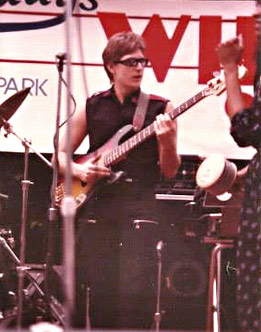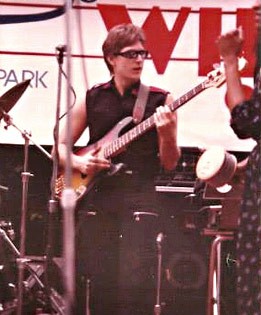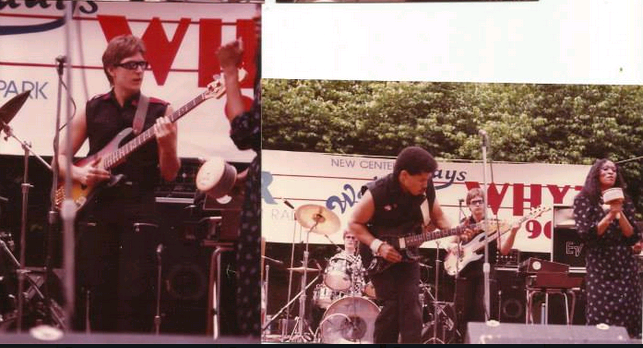
Hugh J. Hitchcock performing with Norma Jean Bell & the All-Stars
I went down to Florida with my Thai girlfriend in May of 1982. We both got homesick after a while, so we came back up to Michigan in January of 1983. After returning to Michigan, I scored a gig with Norma Jean Bell and the All-Stars, who had a house gig at a club in Detroit called Axel’s, on Eight-Mile Road — the same Eight Mile Road that Eminem named his movie after. (I had some gigs in the same city where Eminem grew up — Waterford township — and I’ve worked with Eminem’s producer, Luis Resto! But that is a different story.)

I had already known who Norma was long before I got the gig with her, because I had seen her in concert at Cobo Arena in Detroit, with Frank Zappa, way back around 1974. I was a real Zappa freak and had gone to see his Overnight Sensation tour (repertoire included “Dynamo Humm”, “Zombie Woof”, “I am the Slime”, etc.) The first time I saw Norma Bell she was onstage with Napoleon Murphy Brock and George Duke, and, of course, Zappa himself. I was immediately fascinated by this funky saxophone playing soul sister who could hang with the likes of Frank Zappa. Zappa had been my musical idol and main inspiration since adolescence. I always wondered about her after that concert, didn’t hear of her again for a while but I remembered her name: Norma Bell. Later to be known as Norma Jean Bell. I later found that Norma had worked not only with Zappa but also with Carlos Santana, Tommy Bolin, Narada Michael Walden, even the Mahavishnu Orchestra. As her tune claims, she is definitely “the Baddest Bitch” LOL!
 So when I heard that she needed a bass player, I jumped on the phone and called for an audition. When I learned that not only Trenita Womack, the spirited singer / percussionist / flautist from locally and nationally famous Detroit disco funk band Brainstorm was on the gig, but also Belita Woods, Brainstorm’s stupendous lead singer, I was absolutely thrilled. With them also on keyboards, was the incredible David Lee Chong (David Spradley) of Parliament / Funkadelic, who had created the music tracks for George Clinton’s hit, “Atomic Dog”, among others. In addition, Randall Jacobs was brought into the group on guitar. Randy is well known for having been the lead guitarist for Michael Henderson’s recording releases, as well as his road tour. Henderson songs to which Randy had contributed include the 1978 hit dance tune, “Wide Receiver”. He also played on and helped write the song “Walk the Dinosaur” when he was with Was Not Was. Randy, an incredible showman in his own right, currently tours with Dave Koz. I ended up getting the gig with Norma after the audition, I guess they liked me. So I worked with them all at Axel’s for close to a year.
So when I heard that she needed a bass player, I jumped on the phone and called for an audition. When I learned that not only Trenita Womack, the spirited singer / percussionist / flautist from locally and nationally famous Detroit disco funk band Brainstorm was on the gig, but also Belita Woods, Brainstorm’s stupendous lead singer, I was absolutely thrilled. With them also on keyboards, was the incredible David Lee Chong (David Spradley) of Parliament / Funkadelic, who had created the music tracks for George Clinton’s hit, “Atomic Dog”, among others. In addition, Randall Jacobs was brought into the group on guitar. Randy is well known for having been the lead guitarist for Michael Henderson’s recording releases, as well as his road tour. Henderson songs to which Randy had contributed include the 1978 hit dance tune, “Wide Receiver”. He also played on and helped write the song “Walk the Dinosaur” when he was with Was Not Was. Randy, an incredible showman in his own right, currently tours with Dave Koz. I ended up getting the gig with Norma after the audition, I guess they liked me. So I worked with them all at Axel’s for close to a year.
Oh – and one more really important detail I had left out earlier, is the fact that the reason I was able to get the gig was because the bass player was leaving the group. That bass player was the illustrious Kern Brantley. He was leaving the group because he had gotten a gig going out on tour with Earl Klugh, international jazz guitar celebrity, who happens to be from Detroit. He had come in and seen Kern play there with Norma and offered him the gig. So, to my luck, Kern was leaving and I jumped on Norma’s gig. On Kern’s last night, which was my first night, Earl Klugh came into the club and sat in with the band. Earl had recently been on tour with George Benson, as I recall, and was enjoying quite a bit of popularity at the time, as well as being featured regularly on Detroit’s WJZZ radio (the Jazzy One). Readers will be interested to know that Kern Brantley is now the musical director for the Beyonce show and also works regularly with Ne-Yo and Anita Baker and many others. A very successful fellow, that Kern, “King of Kings” LOL. Yes, indeed. I also have learned that Kern’s brother (is it Valdez?) is now the musical director for Usher. Quite a phenomenally musical family, the Brantleys.
Axel’s was like a speakeasy. A single building built on the road frontage of Detroit’s central Eight Mile Road, you entered through the front door and paid a cover. Once you were inside, you were seated at one of the 60 or so tables inside the building’s main 50x150ft room which was the main nightclub area. At the back of the room was the stage — an actual elevated stage with footlights and a curtain, from behind which the band would enter, dramatically, for each of three shows a night. Lighting effects and sometimes even smoke machines were used at the opening of each show to give a concert-like effect for the patrons of the speakeasy. Said patrons included nightlife afficionados of the Detroit area, party people who appreciated good music and good shows. And with a little money, as it cost a generous cover charge to get in, and a two drink minimum per show. Frequently the entire audience would change between shows, excluding the die-hards who would pay twice or three times just to hang out with Norma for the entire evening.
Norma was a visionary when it came to putting together shows. Not just another band that plays one tune after another, hers — but an entire world-class concert performance wrapped up in each show. She would not have it any other way, her standards were very high, admirably so. But then she’d cut her musical teeth on Frank Zappa, so there you go.
So besides being a master of her instruments, the soprano and alto saxophone, and a shining vocalist, I also consider Norma Jean Bell to be a choreographer and an architect. Three sets were played each night, and Norma designed each one with a different story arc, having a beginning, a middle, and an end, with lots of fireworks and surprises in between. Besides delivering Detroit style funk-fueled excellence in the hard driving music we played, she was not afraid to have the band completely freak out with artistic noise for ten minutes, if it got us where we were going (as you will hear on the tape!) She painted pictures with sound and lights; she was equally disposed to putting on dramatic space-opera type theatrics, involving things like simulating spaceships landing (probably a Funkadelics-influenced theme) and simulated nuclear war — which was a real possibility at the time. (just to put the story in historical context, this was Reagan’s year of “The Day After” and the KAL 007 incident, among other cold-war antics.)
And Norma schooled us sidemen in attitude before she sent us onstage. We were to remain aloof and “cool”. At one point, she had me put down my bass and come out front to sing David Bowie’s “Let’s Dance” as a frontman. She instructed me exactly how I was to play it, what poses to strike, suggested I wear sunglasses, really built a persona. Not that I don’t have one, it’s just that Norma had a concept and applied it to me, and it worked, all right… I had women giving me the phone numbers on napkins from the front row — but I was already promised to the Thai girl, remember…
At any rate, working with Norma Jean Bell, and putting on her show, was a charismatic multimedia funk and soul experience — a pleasure to work every night, as Norma would charm and captivate the audience with her saxophone stylings as well as her commanding “ringmaster” attitude.
When I first joined with the band, our opening number was Vanity 6’s “Do You Think I’m a Nasty Girl?”, flirtily sung by the three ladies at the front — Norma, Belita, and Treaty. What can I say, it was a sassy, titillating opening for the show, a real pleasure to view and listen to, let alone be a part of. Then the band would go into a very original arrangement of an old Burt Bacharach classic, “Walk On By”, entreatingly sung by the great Treaty Womack, to be followed by Michael Jackson’s “Beat It”, which featured a huge synthesizer opening by Chong followed by Van-Halenesque guitar work from Randy Jacobs.
The most amazing number that I can remember the ladies doing, is David Sanborn’s “Love Will Find A Way”. This tune, if you are not familiar with it, provides an opportunity to at once become very intimate with an audience during the quiet and endearing verse sections, and at the same time a chance to express the intensity of feelings during the wide open chorus sections. Norma easily outdid Sanborn in emotionally beautiful saxophone emanations, only to be almost outdone by Belita’s heart-wrenching interpretation of the vocals. Truly a transcendental memory, thanks ladies, for that. Too bad I don’t have a recording of that! Don’t think so, anyway… but the jury’s still out, as there are still many tapes for me to go through and maybe I’ll find something else.
The recording that I do have, you should be listening to now, if your computer is configured for sound and flash. It was made inside Axel’s one night in March of 1983. The listener can pick up the lively speakeasy atmosphere of Axel’s in the ambient noise on the tape. The listener can also get a feel for the showmanship of the group and the architecture of the show.
One can hear at the beginning of the recording, in the opening to the Police’s “Spirits in the Material World”, David Lee Chong saying “Wake up, man! And take a look around you.” Really very evolved, simple, and elegant. Working with David was such a pleasure, as he is a very nice, laid back dude, but he generated attention from his central command and control module. The relaxed, funky attitude he brought with him probably came from working with the Funkadelics. Originally from California, he’s of Korean-american extraction. He was married to a Detroit woman and sometimes she would make extra money at Axel’s by selling food she prepared.
David Spradley, as he is also known, played the role of the spaceship’s captain and navigator onstage. His keyboard array was perched at the front-most corner of the elevated stage, overlooking both the patronage and the rest of the band. “Commander David, requesting permission for landing,” Norma intones, during a simulated alien invasion. After the landing occurs, Commander David advises the audience: “We are not going to hurt you, we only want you to have — some — FUN!!” Then is unleashed a fury of girlish squeals, spacey synthesizer patches, and guitar feedback, explosively leading into the Prince song “1999”.
 at the end of the recording, Randy Jacobs is featured on a guitar solo at the end of the song “1999”. Randy was famous for his histrionics during shows, and this one was no exception, as you will hear. As the band builds up to a climax at the end of Randy’s guitar solo, and as the sound reaches a frenzied pitch, Randy unplugs his guitar chord, grabs his guitar tight and makes a running leap off the stage into the audience and runs out the front door of the club with his guitar! Then re-enters from backstage. You can hear on the recording the huge applause when he makes his flying leap — it was always a real crowd-pleaser and it’s hard to miss the audience’s reaction! The tape is about 15 minutes long, if you listen to the whole thing you will hear it right at the end.
at the end of the recording, Randy Jacobs is featured on a guitar solo at the end of the song “1999”. Randy was famous for his histrionics during shows, and this one was no exception, as you will hear. As the band builds up to a climax at the end of Randy’s guitar solo, and as the sound reaches a frenzied pitch, Randy unplugs his guitar chord, grabs his guitar tight and makes a running leap off the stage into the audience and runs out the front door of the club with his guitar! Then re-enters from backstage. You can hear on the recording the huge applause when he makes his flying leap — it was always a real crowd-pleaser and it’s hard to miss the audience’s reaction! The tape is about 15 minutes long, if you listen to the whole thing you will hear it right at the end.
Band Personnel:
Norma Jean Bell
Alto and Soprano Saxophones, Vocals, MC
Belita Woods
Lead Vocal
(Belita toured with George Clinton and P-Funk until her death in 2012)
Trenita Womack
Vocals, Timbale & Cymbals, Flute
Randall Jacobs
Lead Guitars
(currently with Dave Koz)
David Lee Chong
Keyboards, Vocals, MC
Bruce Parker
Drums
Hugh Jarvis Hitchcock
Bass, Vocals

